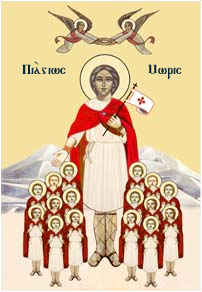Maurice
Saint Maurice was the leader of the legendary Roman Theban Legion in the 3rd century.
The traditional story is that the legion, entirely composed of Christians, had been called from Thebes (Egypt) to go to Gaul, to assist Emperor Maximian, which they did valiantly. However, when Maximian ordered them to harass some local Christians, they refused, and Maximian ordered the unit punished. Every tenth soldier was killed, a military punishment known as decimation. More orders followed, they still refused, due in part to encouragement from St. Maurice, and a second decimation was ordered. In response to their refusal to use violence against fellow Chistians, Maximian ordered all the remaining members of the 6,600-man unit executed. The place in Switzerland where this occurred, known as Agaunum, is now Saint Maurice-en-Valais, site of the Abbey of Saint Maurice-en-Valais.
So reads the earliest account of their martyrdom, according to the public letter of Eucherius, bishop of Lyons (c. 434 – 450), addressed to his fellow bishop Salvius. Alternate versions have the legion refusing Maximian's orders only after discovering a town they had just destroyed had been inhabited by innocent Christians, or that the emperor had them executed when they refused to sacrifice to the Roman gods.
Details of this story rest on tenuous historical grounds: for example, decimation had not been used to discipline a Roman legion for centuries: the previous documented execution of this sentence was in the reign of Galba, who ordered this done to a formation of marines that Nero had formed into a legion, and who demanded an eagle and standards. Further, Christians commonly refused to serve in the military, and the military were staunchly following Isis or Mithras (sol Invictus), until Constantine's time at the earliest, making it unlikely they filled an entire legion.
Some historians suggest that this was a pious fabrication by bishop Theodore of Octodurum sometime between 388 and 394, whom Eucherius, bishop of Lyon, cites as his source of this story, to encourage his contemporary Christians serving in the Roman army to ignore the orders their pagan superiors and instead side with the Christians. If it was a later fabrication, by Eucherius himself, its dissemination was certainly successful in drawing pilgrims to the abbey at Aguanum. That institution was created ex nihilo from 515 onwards by Sigismund, the first Catholic king of the Burgundians. The abbey was unique in its time as the creation of a king working in concord with bishops, rather than an organic development that occurred round the central figure of a holy monk. The new abbey was without doubt in need of a strong founding legend.
Saint Maurice became a patron saint of the Holy Roman Emperors. In 926, Henry I (919-936), even ceded the present Swiss canton of Aargau to the abbey, in return for the sacred lance of the saint's. The Sword of Saint Maurice was part of the regalia used at coronations of the Austro-Hungarian Emperors until 1916.
In 929 Henry I the Fowler held a royal court gathering (Reichsversammlung) at Magdeburg. At the same time the Mauritius Kloster in honor of St. Maurice was founded.
In 961, Otto I was building and enriching the cathedral at Magdeburg, which he intended for his own tomb. To that end,
- "in the year 961 of the Incarnation and in the twenty-fifth year of his reign, in the presence of all of the nobility, on the vigil of Christmas, the body of St. Maurice was conveyed to him at Regensburg along with the bodies of some of the saint's companions and portions of other saints. Having been sent to Magdeburg, these relics were received with great honour by a gathering of the entire populace of the city and of their fellow countrymen. They are still venerated there, to the salvation of the homeland." — Ottonian Germany: The Chronicon of Thietmar of Merseburg, David A. Warner, (Manchester, 2001), p. 104.
Maurice is traditionally depicted in full armor, in Italy emblasoned with a red cross. He is often shown as a Moor, especially in the Magdeburg sculpture (left) and other eastern German depictions. In folk culture he has become connected with the legend of the Spear of Destiny, which he is supposed to have carried into battle; his name is engraved on the Holy Lance of Vienna, one of several relics claimed as the spear that pierced Jesus' side on the cross.
The Indian Ocean island state of Mauritius was named after Maurice of Nassau, a member of the House of Orange, and not directly after St. Maurice himself.
See also
Source
External links
Categories > Church History
Categories > Church History
Categories > Church History
Categories > Church History
Categories > Liturgics > Feasts
Categories > Liturgics > Feasts
Categories > Liturgics > Feasts
Categories > Liturgics > Feasts
Categories > OrthodoxWiki > Articles needing cleanup
Categories > People > Saints
Categories > People > Saints > Ante-Nicene Saints
Categories > People > Saints > Martyrs
Categories > People > Saints > Saints by century > 3rd-century saints
